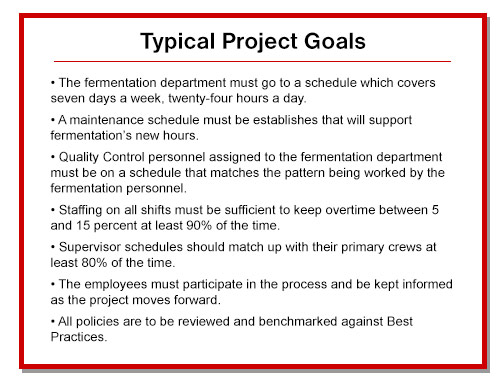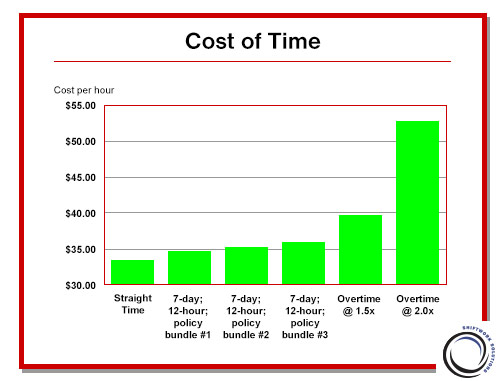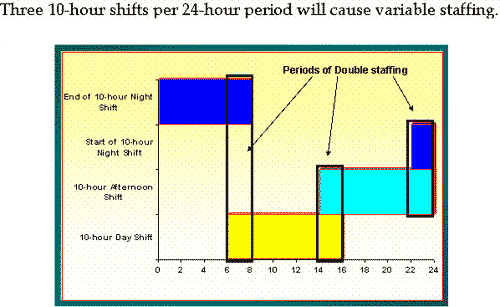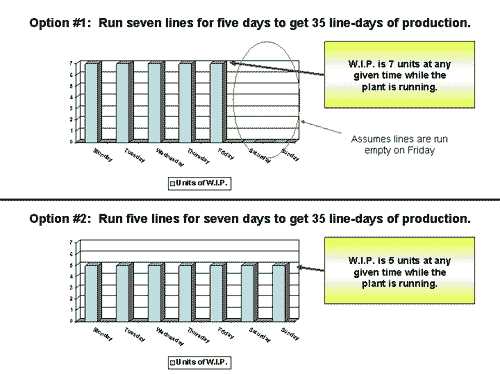All of our consultants all have at least 15 years of experience evaluating shift schedules for a variety of industries and situations. We work with you to evaluate your operation from a shift work perspective. We also look for opportunities that exist beyond the original project goals This allows us to increase the value of our services without increasing the cost to you.
The business analysis is directed by the project goals. These goals are established at the beginning of each project. Some typical project goals are shown in Figure 1.

The business analysis is conducted to determine feasible methods of attaining these goals. Often, there are several alternatives that will get a company the results they want. Our analysis will help identify the cost/benefit of each potential alternative.
When evaluating your shift schedule(s), it is important to understand the actual cost of providing coverage. This analysis of the cost of time determines the cost to the company of purchasing bulk labor hours at a straight time rate (hiring an employee) compared to purchasing additional labor hours one at a time (using overtime). Knowing these costs is critical when calculating optimum staffing levels. An example of how the actual cost of labor varies depending on the situation is shown in Figure 2.

Many of our clients are looking for a process that will take them to a 24×7 schedule. In these instances, our analysis is focused largely upon reviewing equipment utilization and determining who will be impacted by the change and to what extent.
A change in one department almost certainly means that other departments are going to be affected. This is especially true for support departments such as quality, maintenance, and payroll.
A portion of every analysis is dedicated to existing pay and work policies. We must have a clear understanding of these policies before we can determine the impact they will have on the new schedule (or the impact the schedule will have on them.) Frequently, these policies can be a source of schedule inefficiency, employee dissatisfaction, and higher costs.
Often we are contacted about specific issues that require a unique analysis. For example, are 10-hour shifts feasible for a specific operation? There are several criteria that must be met prior to a 10-hour schedule being implemented. Implementing a 10-hour schedule under the wrong conditions can be extremely costly. In this instance, a portion of our analysis is designed to see how well a 10-hour schedule will fit into the operation. For example, Figure 3 shows how three 10-hour shifts result in variable staffing – which may, or may not, fit the coverage requirements.

Other questions to think about: Who will be impacted by it? How will it be staffed? Can the overall operation support it without changing their schedules as well? How efficient is it compared to other schedule alternatives?
Many companies are moving towards the elimination of waste and are actively pursuing a Lean Manufacturing environment. In these instances, an analysis of the impact of different schedules on Lean Manufacturing is appropriate. An example of this type of analysis is shown in Figure 4.

Implementing a schedule that allows for continuous operations can greatly improve their operating efficiencies by lowering inventories, relieving bottlenecks and improving response times to customer orders.
These are just some of the issues that may need to be addressed during the business analysis of your schedule and potential alternatives to your schedule.
Call Us and We Can Help
Call or text us today at (415) 763-5005 to discuss your operations and how we can help you solve your shift work problems. You can also complete our contact form and we will call you.

